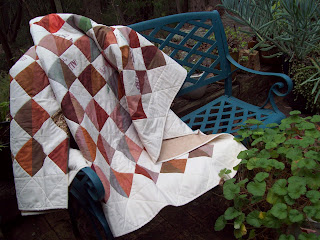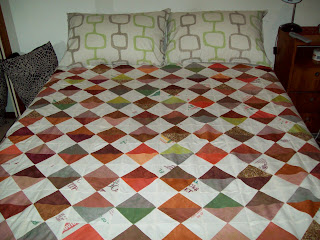
I’m not sure how long ago Jan asked me to make a quilt to represent her connection with magpies, starting from when she was a young girl and throughout her life as her journey unfolded through memory and in her writings. Her story, entitled ‘Coming Home to Myself’ and as described in the fly-leaf, is ‘the story of a woman’s journey to find herself through the maze of deep, unconscious feelings... of depression, child abuse, addiction and recovery, confusion and hope… in a time of rebirthing of feminine consciousness… of women speaking out and reclaiming their lost tradition.’ A Jan took to writing her story in 1994 as ‘part of the healing process’, I have often thought that the healing was somehow continuing through my process of putting together the stages of her story in the various sections of the quilt; and hopefully will continue for us all through the now finished piece, with the voice of the feminine shining through to nourish and celebrate ‘the collective wisdom and voices of the women who have gone before us.’
The creative process begins:
One question I’m often asked is ‘how long did it take to make?’ The answer to that is not as easy as it may sound. My internal response is ‘How do you measure the time of preparation, collection, sorting ideas, and all the instances that the mind wanders back to the quilt in creation?’ I guess the time sitting behind a machine can be measure in hours, days, weeks – but I always forget to record the hours, because there are always interruptions, breaks in the process, some of which may last for years! And it’s impossible to record the other internal process in the sequence of minutes that we call time.
The creative process according to the Wheel of the Year was a focus of my PhD thesis, and as I create I am becoming more aware of the various stages in the process, stages that, as they are seen to resonate with the cycles of nature, are necessary for creation to occur. Setting its own speed, or rate of progress, the creative process can be quite quick – all the seasons experienced in quick succession; or very slow. And of course, each stage is often repeated over and over, in repeating cycles during the creative process.
After Jan asked me to make a totem quilt for her deep connection to magpies, I started by reading the poem she had written early in her monologue under the chapter heading ‘The Story of the Magpies’. In a series of interconnected stories, the text is divided into quite distinct stages. Nevertheless there is an underlying thread of the magpie story present throughout, although not always directly referenced. It is as though her ability to hear the song of the magpies and the story they told through song, was the way deeper realisations about the stages in her life’s journey were revealed, bringing understanding and healing. Clearly the magpie as a beautiful Australian bird was the central motif, but there was so much more that needed to be told.
Contrary to religious teachings, that all that is in Creation comes out of nothing, I experience creativity as beginning with a collection of all that may be something else in itself at the time, namely scraps of fabric and ideas, brought together much as a collection of ‘seeds’ from the ‘fruits’ of a previous harvest. What we fondly call our ‘stash’ is our collection of seeds. Long ago I started pulling out different fabrics from my collection, putting them into a plastic tub as ideas about what to ‘re-present’ in the quilt were gestating. I knew they would not all be manifest in the 50 by 90 cms quilt. Jan had given me the size, which helped contain the profusion of ideas and forms that came flooding in as I read her story, thought about the physical landscape of her habitation and the invisible landscape of her soul. The colours and textures of the former were aroused by my memories of the Australian bush, rocky, mostly drought-stricken; and the knowledge that she lives with the husband on a property outside Wagga Wagga, with a 360 degree view of her surrounding landscape, scattered with yellow-box eucalypts. The soul landscape I’d absorbed from her text aroused visions of travelling through the dark night into the fullness as experienced in watching moon cycles; our menstrual cycles as the ultimate creative expression for women; and of course, the seasons. This resulted in including into the tub full of shades of earth browns, bush greens, black and whites for the magpies. Most of them were hand-dyes, since I like their natural feel, though I had no idea how they were to manifest for this ‘magpie totem quilt’.
Then there were the Goddess screen prints I treasure, left over from previous quilts. I had two goddesses in various colours: the Bird-headed Goddess form ancient Egypt and the little Goddess Mother from Willendorf. Then I started to think of other ways to increase my Goddess stash, with those I’ve loved for a long time. This idea, together with the need to ‘observe’ the shape of magpies, took me to the computer to search and scan. I decided to do some fabric printing onto fabric using the Bubble Jet Set stuff: some text from Jan’s book, the poem, some magpies and maybe some more goddesses.
Symbols arousing memory
When I think about this quilt, it could be presented as a portrait, because it is a portrait, in the same way that this year’s winner of the Archibald Tim Storrier conceives of portrait – through representing life events and symbols, rather than a personal likeness. The significant events of Jan’s life as she refers to them in her memoir form the basis of the design for her quilt. Four phases of the moon are another symbolic thread from which Jan’s story could unfold, starting with the full dark moon, moving through to a new moon, waxing moon, arriving at the fullness of a golden-pink harvest moon. The first ‘block’ to come forth was the fronds of the tree fern, gradually unfurling as memory unfurled. The river was an important symbol in the poem, of the joy and freedom of the magpies, and eventually the ancient bird-headed snake Goddess found her way to ride on the waters in her freedom and triumph – this time in the boat of a eucalyptus leaf! Another Goddess symbol is the Great Mother (of Villendorf) is encased also by eucalypt leaves as she gives birth of self and all-that-is from her connection to the life-giving energies of land and waters out of which the yellow-box eucalypts live, die and are reborn. A rainbow is mentioned in Jan’s story, a clear symbol of hope, new life, as are dragonflies. In the quilt a dragonfly hovers almost invisibly over the circle of leaves reminding us of the ever-rotating cycle between light and dark that is Earth’s Creation, shown in the creative cycle of the seasons.
After having ‘collected’ many different magpie images, and playing around with their positions on the quilt, finally a single magpie found her place at the bottom, looking up as witness and to celebrate Jan’s story, the Mother having given the magpies the ‘special task of calling forth her spirit into the light of exquisite, pure sound… in ways that words could not… to bring messages of hope and comfort; meaning and connection; of pure delight and celebration; of healing.’
There is much more to say about the process of making the quilt, but this will suffice for now!







